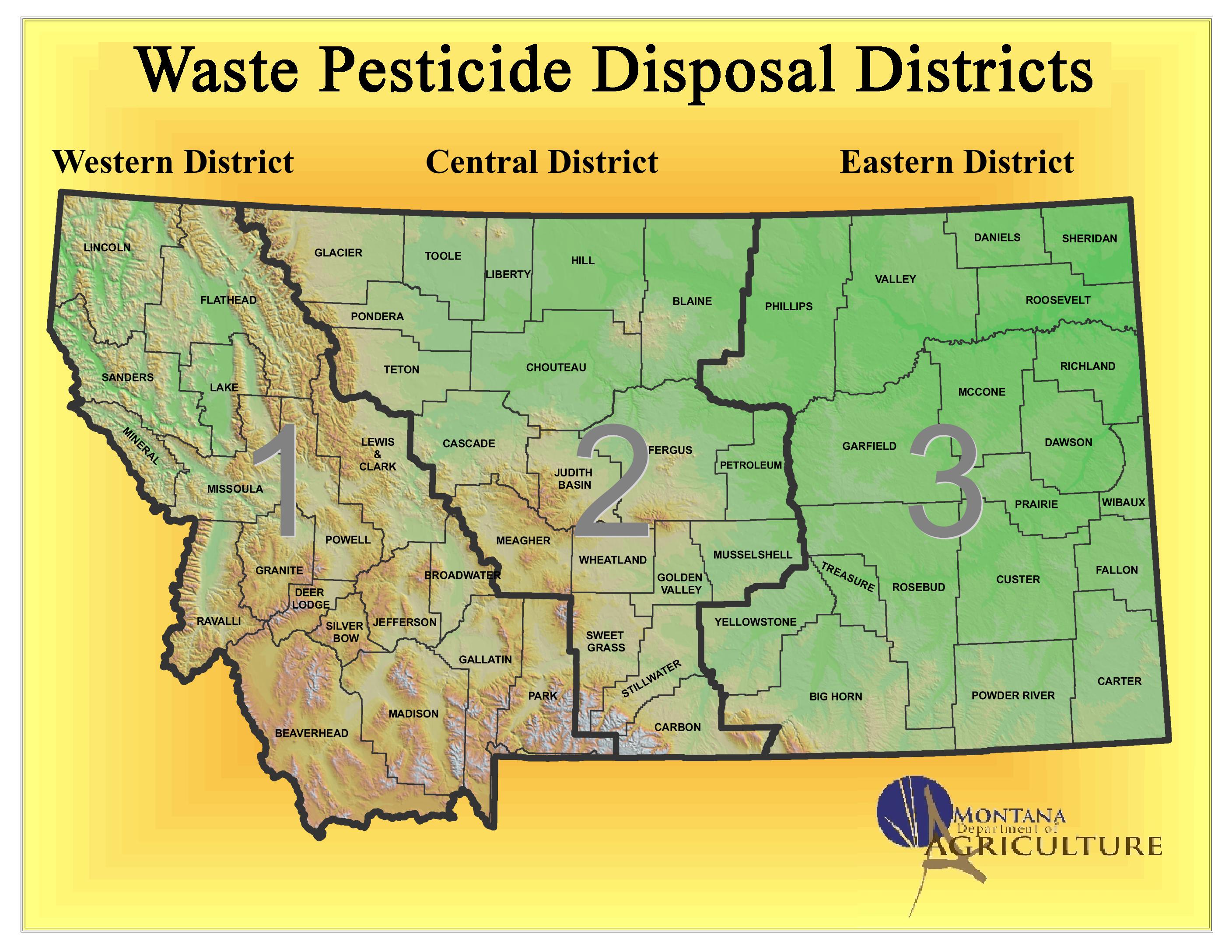Frequently Asked Questions
A program sponsored by the Montana Department of Agriculture that collects and properly disposes of waste pesticides and metal pesticide containers. For most participants the program is free. Participants with more than 200 pounds of waste pesticides are charged a subsidized rate for disposal of the extra material.
Any pesticide product that the owner cannot or does not wish to use is a waste pesticide, and is a suitable candidate for the disposal program.
In most cases, the person, company or organization that purchases or controls a pesticide is legally responsible for its proper use, handling, storage, and disposal. For more information contact the Montana Department of Agriculture. It is illegal to bury, burn, or discard a pesticide or its container in a manner inconsistent with instructions found on the label. The disposal program is the easiest, safest, and usually the only legal option for proper disposal of these materials.
Pesticides may become unusable for many reasons, even simply because the person possessing them no longer has a use for them. Some products have a limited shelf life, or may undergo changes in storage that render them unusable. Identifying labels and use directions deteriorate with age, often to the point of becoming unreadable or completely missing. Many liquid products become unusable after being frozen, for example, and many dry formulations like dusts or granules may become unusable if they get wet. In some cases pesticides become unusable because their registrations are expired or canceled, and legal uses for them no longer exist. It is also not uncommon for people who inherit or purchase agricultural properties to find unusable pesticides in storage. All of these circumstances make pesticides unusable, and all of these examples are suitable for the MDA disposal program. If you have questions about the use, status or condition of a pesticide, contact the Montana Department of Agriculture at (406)-465-0531. It is helpful, but not necessary for participation, to provide the product's name, manufacturer, and U.S. EPA registration number found on the product's label.
Because of the inherent hazards associated with most unusable pesticides, disposal at a permitted hazardous waste facility is the only acceptable and legal disposal practice. The Montana Department of Agriculture contracts with a licensed hazardous waste company to collect and properly dispose of waste pesticides. One collection per year will take place in one of the three waste pesticide disposal districts in the state of Montana. For more information, refer to the When and Where section on this page.
The basic process for the Montana Department of Agriculture Waste Pesticide Collection Program goes like this:
- The participant pre-registers unusable pesticides and empty metal pesticide containers with the Montana Department of Agriculture
- The participant or the participant's designee brings the pre-registered pesticide to the collection site. During transportation the material is legally considered an ordinary pesticide. It is not yet hazardous waste.
- Upon arrival at the site, the pesticide is turned over to a licensed hazardous waste contractor. The pesticide become hazardous waste at that point, and the contractor assumes ownership and liability.
- The contractor packages the material for transportation, hauls it away, and properly disposes of it.
The program serves all the citizens of Montana. Although licensed pesticide applicators are the program's primary clientele, anyone with waste pesticides may apply. Cost to the participant is based on the weight of the waste pesticide and its container. Products are weighed on site at the time of transfer.
- The first 200 lbs are FREE.
- $1.00 per pound for additional amounts over 200 pounds, with a $5.00 minimum.
- The department may elect to accept pesticides that contain dioxin or heavy metals into the program at a higher fee.
The program will collect and dispose of most unusable pesticides and metal pesticide containers. Empty plastic pesticide containers, fertilizers, waste oil, paints and any other non-pesticide material will not be accepted.
Pesticides with a missing label or unknown pesticides can be accepted into the disposal program. In most cases, the hazardous waste contractor can characterize the waste at the collection site. Large volumes of an unknown pesticide may require analysis before acceptance into the collection. Contact the Montana Department of Agriculture for more information if you have a large quantity of an unknown product. The participant should be reasonably sure that the unknown material is a pesticide. Any information about the material should be provided.
The Montana Department of Agriculture also provides a free container-recycling program. Container Recycling Program.
Yes, program participants are relieved of future liability going forward when the product is delivered to the contractor. At that point the disposal contractor becomes the hazardous waste generator and owns both the waste and the liability. All pesticides accepted into the program are incinerated at an EPA- licensed facility to reduce possible future pollution liability.
No. The Montana Code Annotated (MCA) 80-8-111 specifies that a person may not be subject to an administrative or judicial penalty or action as a result of participation in the disposal program. The point of the program, after all, is to reduce the risk of harm to human health and the environment by encouraging proper and responsible disposal of unusable and waste pesticides.


